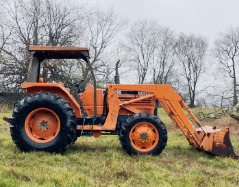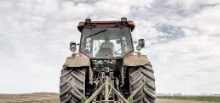________________________________________________________________________________________
Kubota M6950 Troubleshooting
 The
Kubota M6950 utility tractor was manufactured from 1983 to 1993. This model has
two version: M6950F (2WD) and M6950DT (4WD). The Kubota M6950 powertrain system
components: a 243.1 cu.in (4 L) Kubota V4000-2A vertical 4-cylinder naturally
aspirated liquid-cooled diesel engine and fully synchronized transmission with
12 forward and 4 reverse gears. The engine has a cylinder bore of 4.13" (105
mm), piston stroke of 4.53" (115 mm), and rated power of 71 hp (52.9 kW). The
maximum travel speed (forward/reverse): 16.7 mph (26.9 kph) and 7 mph (11.3
kph).
The
Kubota M6950 utility tractor was manufactured from 1983 to 1993. This model has
two version: M6950F (2WD) and M6950DT (4WD). The Kubota M6950 powertrain system
components: a 243.1 cu.in (4 L) Kubota V4000-2A vertical 4-cylinder naturally
aspirated liquid-cooled diesel engine and fully synchronized transmission with
12 forward and 4 reverse gears. The engine has a cylinder bore of 4.13" (105
mm), piston stroke of 4.53" (115 mm), and rated power of 71 hp (52.9 kW). The
maximum travel speed (forward/reverse): 16.7 mph (26.9 kph) and 7 mph (11.3
kph).
The open center hydraulic system has a gear pump with a rated capacity
of 11 gal/min (41.6 l/min). The hydraulic pressure is 181 bar (2630
psi). The 2-wheel drive models are equipped with 7.50x16 front tires and
18.4x28 rear tires. The 11.2x24 front tires and 18.4x28 rear tires are
used for 4-wheel drive tractors. The Kubota M6950 tractor can be
equipped with the following attachments:
Kubota M1850A front-end loader
with a lift capacity to full height of 2630 lbs (1192 kg) and breakout
force of 4640 (2104 kg).
| Engine Troubleshooting |
| Engine will not start or difficult to start |
| Clogged fuel filter element - Change filter element |
| Closed fuel supply valve - Open supply valve to inject fuel |
| There is air in the fuel system - Bleed the system |
| Dirty or faulty injectors - Change fuel injectors |
| Fuel injection pump is not operating properly - Rebuild or replace pump |
| Bad compression - Check cylinder block and replace defective parts |
| Engine shuts off while driving |
| Engine is not warmed up to required temperature - Normalize the engine temperature |
| There is air in the fuel system - Bleed the system |
| Bad fuel injection - Check and adjust |
| Plugged fuel filter - Clean or change the filter |
| Fuel injectors are defective or dirty - Service or change fuel injectors |
| Diesel starts but then stalls |
| Unadjusted fuel injection pump timing - Adjust injection timing |
| Fuel filter clogging - Change the filter element |
| Fuel injector nozzles are damaged - Test injector nozzles and replace as required |
| Fuel injection pump is damaged - Replacement or repair required |
| Clogged air cleaner - Change or service air cleaner element |
| Improperly adjusted low idle speed - Normalize low idle speed |
| Fuel injection pump is not working correctly - Install a new pump or rebuild |
| Fuel injector nozzles are clogged or faulty - Replace fuel injector nozzles |
| Excessive valve clearance - Adjust valve clearance according to specifications |
| Coolant level is low - Fill radiator to proper level. Any leaks must be repaired |
| Cooling system parts are failed or system is clogged - Change faulty components or service cooling system |
| Insufficient engine oil - Checking oil level and add if necessary |
| Unadjusted fan belt tension or worn belt - Adjust belt tension correctly or replace it |
| Defective thermostat - Replace the thermostat |
| Fuel injectors are damaged or dirty - Change fuel injectors |
| Incorrect fuel injection pressure - Test fuel injection pressure and adjust it correctly |
| Air filter element is clogged - Install new filter element or replace it |
| Engine oil filter is plugged - Change or clean engine oil filter element |
| Engine is overloaded - Reduce the load or operate the tractor in lower gears |
| Valve out of adjustment - Adjust to proper valve clearance |
| Low idle speed setting is incorrect - Correct low idle settings |
| Dirt in the fuel pipes or hoses - Clean fuel hoses and pipes |
| Lack of compression: Intake or exhaust valves are damaged - Change the valves |
| Abnormal engine noise or knocking |
| Incorrect setting of fuel injection pump timing - Fuel injection pump timing adjustment needs to be corrected |
| Fuel injector nozzles are defective or dirty - Replace fuel injector nozzles |
| Engine oil insufficient - Fill up the engine oil |
| Engine has not warmed up to recommended temperature - Warm up engine as required |
| Crankshaft or main bearings failure - Install new parts |
| Piston rings failure - Install new piston rings |
| The flywheel to crankshaft bolts are loose - Tighten bolts as required |
| Oil leakage: Gaskets or seals can be faulty - Change worn parts according to specifications |
| Improper oil viscosity - Use oil of proper viscosity |
| Worn or broken piston rings - Install new piston rings |
| Damaged valve guides or valve stems - Replace the valves |
| Scored pistons or cylinder liners - Check pistons and liners, change as required |
| Electrical System Troubleshooting |
| Battery does not charge |
| Battery dead cell - Battery change required |
| Bad battery cable harness - Inspect cables for malfunctions, repair or change |
| Loose or corroded cables and terminals - Clean or tighten cables and terminals |
| Belt is damaged or belt tension is incorrectly adjusted - Adjust belt tension as required or change belt |
| Low battery power - Charge the battery |
| Battery will not hold charge - Service battery or change it |
| Battery electrical wire harness damage - Check battery wires for damage, replace or change |
| Loose or corroded cables and terminals - Tighten or clean cables and terminals |
| Low battery output voltage - Charge the battery |
| Discharged or worn battery - Recharge or replace battery |
| Starter motor failing - Repair or change starter |
| Disconnected or incorrectly connected wiring harness - Inspect wiring harness and reconnect it as required |
| Transmission Troubleshooting |
| Hard to shift gears |
| Failure or improper clutch adjustment - Adjust correctly or replace |
| Damaged or loose gear shift linkage - Repair or change shift linkage |
| Shift forks are worn or damaged - Replace defective shift forks |
| Worn gear shift mechanism - Replace worn components |
| Insufficient transmission fluid pressure |
| Insufficient fluid supply - Fill the transmission housing with fluid |
| Plugged transmission fluid filter (if equipped) - Change or clean the transmission fluid filter |
| Damaged relief valve - Change relief valve |
| Bearings are worn or broken - Faulty bearings should be replaced |
| Insufficient fluid supply - Fill the transmission housing with fluid |
| Dirty transmission fluid - Change transmission fluid |
| Gears are defective or backlash is incorrect - Replace gears or set backlash correctly |
| Worn or damaged shift forks - Shift forks need to be replaced |
| Gaskets or seals are damaged - Install new components |
| Cracked transmission case - Install a new transmission case |
| Hydraulics Troubleshooting |
| Hydraulic system overheated |
| System pressure has not been adjusted correctly - Pressure needs to be adjust correctly |
| Main relief valve incorrect adjustment or failure - Adjust the valve or replace if necessary |
| Hydraulic fluid is dirty - Hydraulic fluid change required |
| Air leaks in hydraulic system - Inspect the suction line, pump seals, and fittings |
| Low hydraulic system pressure |
| Not enough hydraulic fluid in the system - Check and refill the hydraulic fluid |
| Hydraulic oil filter is dirty - Install a new hydraulic filter element |
| Faulty hydraulic oil pump - Test the pump flow rate and change pump if required |
| Defective or not adjusted hydraulic spool valve - Replace or set properly |
| Broken hydraulic cylinder - Inspect cylinder components for wear or damage and change if required |
| Hydraulic lines are leaking - Detect leaks in the system and fix it |
| 3-point hitch lifts too slowly or can't lift |
| Hydraulic oil level is insufficient - Fill up the hydraulic oil |
| Cold hydraulic fluid - Warm up the fluid |
| Hydraulic fluid filter element is dirty - Change hydraulic filter element or clean if necessary |
| Defective hydraulic pump - Check pump capacity and change if necessary |
| Main relief valve is faulty or misadjusted - Adjust or replace the relief valve |
| Hydraulic spool valve is not set properly or defective - Replace or adjust correctly |
| Hydraulic cylinder is broken - Check cylinder components for wear or damage and change if necessary |
| Damaged or disconnected suction pipe - Connect or replace |
| Hitch does not lower or lowers very slowly |
| Defective or not adjusted hydraulic control valve - Set properly or replace |
| Broken hydraulic cylinder - Inspect cylinder components for wear or damage and change if required |
| Hitch rock shaft is damaged - Install a new shaft |
| Mechanical parts of the hitch are damaged - Change defective or worn hitch components |
| Jerky lowering or lifting of the hitch |
| Air trapped in the hydraulic system - Inspect the pump seals, suction pipe, and fittings |
| Hydraulic fluid is contaminated - Fill up with new hydraulic fluid |
| Faulty hydraulic oil pump - Test the pump flow rate and change pump if required |
| Defective or not adjusted hydraulic control valve - Adjust correctly or change |
| Broken hydraulic cylinder - Inspect cylinder components for wear or damage and change if required |
________________________________________________________________________________________
________________________________________________________________________________________
| Farm Tractors Technical Specifications |
 The
Kubota M6950 utility tractor was manufactured from 1983 to 1993. This model has
two version: M6950F (2WD) and M6950DT (4WD). The Kubota M6950 powertrain system
components: a 243.1 cu.in (4 L) Kubota V4000-2A vertical 4-cylinder naturally
aspirated liquid-cooled diesel engine and fully synchronized transmission with
12 forward and 4 reverse gears. The engine has a cylinder bore of 4.13" (105
mm), piston stroke of 4.53" (115 mm), and rated power of 71 hp (52.9 kW). The
maximum travel speed (forward/reverse): 16.7 mph (26.9 kph) and 7 mph (11.3
kph).
The
Kubota M6950 utility tractor was manufactured from 1983 to 1993. This model has
two version: M6950F (2WD) and M6950DT (4WD). The Kubota M6950 powertrain system
components: a 243.1 cu.in (4 L) Kubota V4000-2A vertical 4-cylinder naturally
aspirated liquid-cooled diesel engine and fully synchronized transmission with
12 forward and 4 reverse gears. The engine has a cylinder bore of 4.13" (105
mm), piston stroke of 4.53" (115 mm), and rated power of 71 hp (52.9 kW). The
maximum travel speed (forward/reverse): 16.7 mph (26.9 kph) and 7 mph (11.3
kph). 